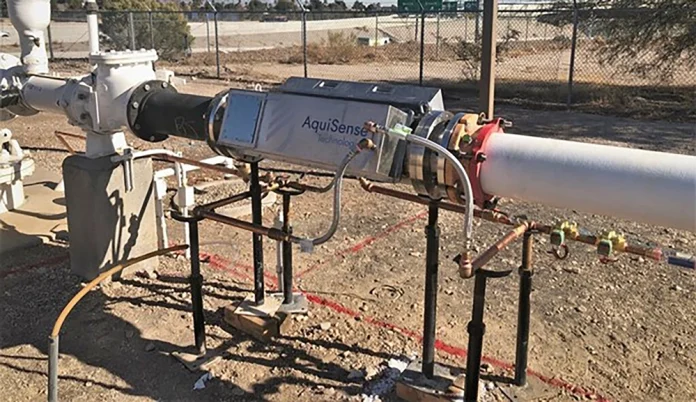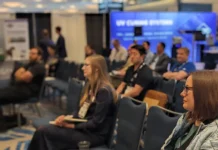Bailey Jones, MS Student, Department of Civil and Environmental Engineering, University of New Hampshire, [email protected]
James P. Malley Jr., Ph.D., professor of civil and environmental engineering, University of New Hampshire, [email protected]
UV LED reactors to be used to provide a multi-barrier to Legionella in Las Vegas Valley Water District
Historically, the UV technology industry has been dominated by mercury vapor lamp technology; however, the research, development and implementation of UV LEDs has been on the rise in recent years, especially for lower flows or levels of disinfection that do not require large values of UV irradiance. One example of this can be seen with the Las Vegas Valley Water District and its efforts to provide a multi-barrier for Legionella.
The Las Vegas Valley Water District has announced that the PearlAqua Tera™ from AquiSense Technologies will be used to treat water in the district. AquiSense Technologies is a US manufacturer of UV LED water disinfection systems. The Tera was created as its first UV LED system designed specifically for municipal and industrial use, and the technology provides chemical-free, mercury-free disinfection housed within a self-contained system. The Tera has a disinfection flow rate of two million gallons a day, with the potential to increase to six million gallons a day if a larger flange is used in the system. The Tera has a minimum lifespan of 20 years, with the only required maintenance being the replacement of its LED bulbs. ¹
One of the main reasons the Las Vegas Valley Water District chose to use the PearlAqua Tera system was that the system was easy to operate. According to the CEO of AquiSense Technologies, the lamps of the system are housed on the outside, making the system more user-friendly as one does not need to remove the water and perform maintenance in situ. ¹
The company has five more projects on the books with the Las Vegas Valley Water District and another seven installations planned over the next year across the US and Asia. If the implementation of UV LED systems continues to increase and proves to be effective, these systems may become another viable option for UV disinfection projects in the future.
Research news on the development of UV LED technology
A request for proposals (RFP) involving the evaluation of UV LEDs released by the Water Research Foundation (WRF) recently has hit its deadline for applications. The objective of the research project, “Feasibility of Full-Scale Implementation of UV LED Disinfection,” is to evaluate the effectiveness of UV LED lights for microbial inactivation and to assess their feasibility in treatment plants. ² With a budget of up to $250,000, this project has the potential to make a meaningful contribution to the field of UV disinfection technology. The teams who submitted their research proposals for the funding likely will hear back from the WRF in February or March.
UV LED research at the AWWA Water Quality Technology Conference (WQTC)
In November 2022, the AWWA WQTC Conference featured a number of excellent presentations and papers related to an array of UV technologies, ³ with UV LED research featured in many of the papers. Dana Pousty and her co-authors presented interesting work on wavelength-dependent time dose reciprocity by evaluating microorganisms’ reactions to low-irradiance sources. This approach may be an essential step in designing efficient UV LED-based disinfection point-of-use (POU) reactors, due to the low output power of the UV LEDs when compared to conventional UV lamps.
Sripriya Dharwadkar, with her mentors Irene Carra and Peter Jarvis, presented current work on UV/HOCl advanced oxidation processes (AOP) operated with UV LEDs, which may allow flexibility of operation and reactor design, as well as the potential to operate the UV/HOCl process at targeted wavelengths. The paper investigated the influence of the wavelength of irradiation on the production of radical species in the UV LED/HOCl process and, in turn, the degradation of pesticides and the treatability of the resulting transformation products.
Wright and Wicklein presented work on maximizing the rate of return on UV AOP systems for potable reuse. Their paper discussed UV systems treating RO permeate to achieve 6 log adenovirus inactivation, NDMA photolysis and 0.5 logs 1,4-dioxane reduction. CFD-based UV dose models were used to evaluate the impact of inlet piping on UV dose delivery by two UV systems and develop UV dose algorithms that account for the UVT increase that occurs through reactors because the UV reduced chloramines, the main UV absorber in RO, permeate for the systems studied.
Chen and co-authors presented a paper on a new way to measure hydroxyl radical scavenging capacity for AOP applications in drinking water. Their study was based on data collected at six drinking water treatment plants over the course of one year and demonstrated that the scavenging potential may change across treatment and with time. The authors recommended routine collection of scavenging capacity data to better design/operate the AOP system.
The One Water column seeks to highlight the application of UV technologies to the traditional areas of drinking water, wastewater, water reuse, agricultural and industrial process water, and stormwater. The goal of the column is to further evolve understanding and focus, driven by YP members, on sustainable water – reminding stakeholders that there is one water cycle on earth.
Resources
- UV-C LEDs going large in Las Vegas. Aquatech. (2022, August 8). Retrieved February 1, 2023, from https://www.aquatechtrade.com/news/water-treatment/uv-project-updates-las-vegas/.
- Water Research Foundation (WRF). (2022, October 18). Request for proposals: Feasibility of full-scale implementation of LED UV disinfection. fundsforNGOs. Retrieved February 1, 2023, from https://www2.fundsforngos.org/latest-funds-for-ngos/request-for-proposals-feasibility-of-full-scale-implementation-of-led-uv-disinfection/.
- American Water Works Association (AWWA). 2022 Water Quality Technology Conference (WQTC) November 13-17, Program and Proceedings. Duke Energy Convention Center Cincinnati, OH, USA





